Chemistry - Difference between intermediates and transition states
Solution 1:
An intermediate is a short-lived unstable molecule in a reaction which is formed inbetween the reaction when reactants change into products.
Whereas, transition state is just the state before formation of new molecule(involves breaking of bonds of reactants and formation of new ones)
An intermediate differs from a transition state in that the intermediate has a discrete lifetime (be it a few nanoseconds or many days), whereas a transition state lasts for just one bond vibration cycle. Intermediates may be unstable molecules (in which case they are called reactive intermediates) or highly stable molecules. The difference between them can be better described through the energy profile diagram.
Transition states are local energy maximums and have partial bonds. This might be one of the reasons why they cant be isolated as intermediates.

Solution 2:
Throughout, I will be using definitions from a Journal of Chemical Education article$^1$ by Keith Laidler.
I'll start with describing an intermediate, as I think it is an easier concept to grasp. An intermediate, according to Laidler, is a short-lived compound formed during a composite reaction. This intermediate is a product of one elementary reaction and a reactant for another. An intermediate must be a minimum on the potential energy surface; this means it will have some finite lifetime (dependent on how deep this minimum is) and could potentially be isolated under the right conditions.
A transition state is a saddle point on the potential energy surface, meaning it is a maximum along the reaction coordinate and a minimum along all other coordinates (this is a slight simplification as it is possible, though rare, to have higher order saddle points where it is a maximum along more than one coordinate). Note that this definition only applies to an elementary reaction; a composite reaction doesn't have one overarching transition state. Laidler defines the broader category of transition species to refer to any structure that occurs while moving along the reaction coordinate between reactants and products. This is an important distinction; note that while a transition state is impossible to detect (it exists only for a very small range of atomic configurations and thus its concentration is always vanishingly small) transition species as whole can be detected as they exist, however fleetingly, in much higher concentration due to being defined for a wider range of atomic configurations. Laidler gives as an example the reaction $$\ce{F + Na2 ->F...Na...Na->NaF +Na^*}$$ where certain emissions surrounding the sodium D-line have been attributed to these transition species.
As some what of an aside, it is worth mention how potential energy extrema and saddle points are determined from a computational perspective. First, we find extrema and saddle points by determining regions where the force vector (first derivative of the energy with respect to all coordinates) is zero. Given the Hessian matrix for a molecule, which gives the second derivative of the energy with respect to all pairs of the 3N coordinates of the molecule (these might be normal modes or cartesian coordinates), one can determine whether the compound is an min/saddle point by examining the eigenvalues of the matrix. If all the eigenvalues are positive, this means the compound is a minimum; if exactly one eigenvalue is negative, it is a saddle point; if $n$ eigenvalues are negative, it is an $n^{th}$ order saddle point; if all eigenvalues are negative, it is a maximum (this is hardly ever the case for chemical systems).
- Laidler, K. J. Just what is a transition state? J. Chem. Educ. 1988, 65 (6), 540. DOI: 10.1021/ed065p540.
Solution 3:
A transition state cannot be isolated while an intermediate can be isolated. A transition state is a chemical species which has only fleeting existence and represents an energy maxima on reaction coordination diagram . While an intermediate lies in depression on potential energy curve . Therefore actual lifetime of an intermediate depends on the depth of the depression. A shallow depression implies a low activation energy for subsequent steps and therefore short lifetime. While deeper the depression longer is the lifetime of intermediate.